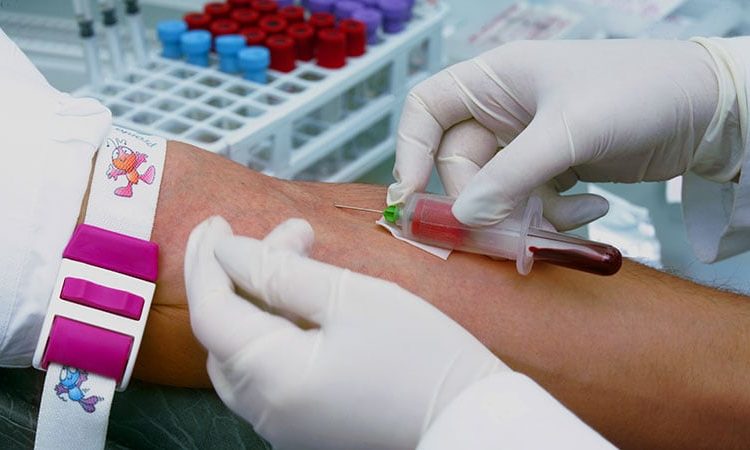Rheumatologists tend to order the same types of tests to monitor their patients’ responses to conventional synthetic disease-modifying antirheumatic drugs (csDMARDs), but they vary widely in how often they order tests and how they respond to abnormal results, responses to a survey suggest.
“The study found that, although guidelines exist, people didn’t follow them consistently. They also responded to abnormal test results in wildly different ways,” senior study author Philip C. Robinson, MBChB, PhD, of the University of Queensland, Herston, Australia, said in an interview.

Dr Philip C. Robinson
“The take-home message of this study is that everyone is doing something different, which means that the system likely has a lot of low-value activity and that money is being wasted,” he added. “However, we don’t have the evidence to guide people to make better choices.”
The literature on laboratory monitoring of people taking csDMARDs for rheumatic disease is scant, the authors wrote in BMC Rheumatology, and current guidelines on csDMARD monitoring vary, likely because of the lack of high-quality evidence for specific monitoring regimens.
“An enormous amount of money is spent on DMARD monitoring with little evidence to support current practices,” Robinson said. So he and his colleagues asked rheumatologists and rheumatology trainees about their attitudes and practices related to laboratory monitoring of csDMARDs in an online questionnaire.
They used the Australian Rheumatology Association newsletter to invite around 530 Australian rheumatologists and trainees, around 4,500 of Robinson’s Twitter followers, and 25 Australian and overseas email contacts, to respond to questions about csDMARDs they prescribed, frequency and patterns of monitoring, influences of additional factors and combination therapy, responses to abnormal tests, and attitudes toward monitoring frequency.
The researchers based their questions on csDMARD monitoring guidelines published by the American College of Rheumatology (which recommends monitoring every 2-4 weeks from initiation to 3 months, every 8-12 weeks during months 3-6, and every 12 weeks from 6 months onward), and from the British Society for Rheumatology (whose guidance is similar but bases monitoring frequency on how long DMARD doses remain stable).
The 221 valid responses they collected included 53 from Australia and 39 from the United States. Overall, 53% of respondents were in public practice, 56% were women, and 56% had practiced rheumatology for 11 or more years.
Respondents reported more frequent monitoring of patients with multiple comorbidities and those taking csDMARD combinations, including methotrexate and leflunomide. Responses to abnormal monitoring results varied widely, and 40% of respondents reported that monitoring tests are performed too often. Compared with females, males reported greater tolerance of significant test abnormalities before acting. They also were more likely to report that guidelines recommend, and doctors perform, tests too frequently.
Testing, Monitoring Patterns Can Differ From Current Guidelines
Rheumatologists who were asked to comment on the survey welcomed its results.

Dr Daniel E. Furst
They came as no surprise to Daniel E. Furst, MD, professor emeritus of medicine at the University of California, Los Angeles.
“Most guidelines point out in the introduction that they are recommendations and need to be modified by specific patient and environmental needs,” he noted in an interview.
Stephen Myers, MD, assistant professor of clinical medicine in the division of rheumatology at the University of Southern California, Los Angeles, said: “The findings seem generally consistent with my observed practices and those of my peers, with the exception of sulfasalazine, which we tend to monitor every 3 months, similar to the way we monitor other csDMARDs.”
Caoilfhionn Connolly, MD, MSc, postdoctoral fellow in rheumatology at Johns Hopkins University, Baltimore, called “the variability in monitoring somewhat surprising given that both the American College of Rheumatology and the British Society for Rheumatology provide guidance statements on optimal monitoring.

Dr Caoilfhionn Connolly
“As the authors highlight,” she added, “the variability in monitoring and response to lab abnormalities is likely driven by the lack of a high-quality evidence base, which should ideally be derived from clinical trials.”
Medication monitoring is critical to ensuring patient safety in rheumatology and other specialties, said Puja Khanna, MD, MPH, a rheumatologist and clinical associate professor of medicine at the University of Michigan, Ann Arbor.
Khanna described how in 2018, the Michigan Medicine health care system revisited its processes and protocols for medication monitoring.
Previously, “we were reliant on society guidelines that were not used consistently across the academic and community rheumatology practices,” she said. “Using lean thinking methodology, we found that we lacked familiarity with laboratory monitoring protocols amongst the interdisciplinary teams involved in the process and that we had a clear need for consensus.

Dr Puja Khanna
“A consistent departmental protocol was created to help streamline the workflow for ancillary support staff, to close identified operational gaps, and to reduce delays in monitoring that impacted safe practice patterns,” Khanna added.
“We developed standardized medication- and disease-based monitoring protocols for eight medical specialties, where the person who writes a prescription that requires monitoring can utilize standard work flows to enroll the patient in the medication monitoring program and have dedicated ancillary support staff follow the results periodically and alert clinicians in a timely manner,” she explained. “Almost 15,000 patients are currently monitored in this collaborative program involving clinicians, nurses, pharmacists, and IT and administrative teams.”
Guidelines May Not Capture Clinical Realities of csDMARD Monitoring
Myers and colleagues may monitor testing more intensively if, for example, a patient becomes ill, has side effects, or has taken medication incorrectly. But they’ll less intensively monitor a patient who’s been stable on a csDMARD.

Dr Stephen Myers
“In my current academic practice, deciding lab monitoring frequency is left up to physicians. In my previous private practice experience, lab monitoring seemed to be more frequent than the current guidelines for many patients, compared to public or academic practice,” he said. “It would be interesting to compare monitoring practices in private, public, and academic settings.
“The clinical reality is that frequent monitoring depends on the regular follow-up, which for some patients is difficult, due to socioeconomic factors including lack of childcare and public transport,” Myers added.
Khanna mentioned that “guidelines tend to provide details of extant practice patterns, usually taken from evidence-based data. With monitoring, however, that is tough to achieve, unless substantial data can be found in large national registries of patients on immunosuppressive medications.”
Experience and comfort with using immunosuppressive medications, and medicolegal liability considerations, especially because many immunomodulatory agents confer adverse effects, can contribute to clinicians’ behaviors varying from guidelines, she added.
A Good Scoping Review, and Further Research Needed
“This article did what it was supposed to do: Define the various approaches to monitoring,” Furst said. “It is the next steps that will make a difference in practice.
“Next steps … may require delving into large observational data sets such as registries to ascertain the consequences of different monitoring strategies for various patient groups and disparate drugs and drug combinations,” added Furst, who coauthored a 2017 review summarizing guidelines for laboratory monitoring in patients with rheumatoid arthritis.
“A significant oversight is the lack of consideration regarding monitoring for corticosteroids, which are well known to have very consequential adverse events and require careful monitoring,” Furst observed.
“The difference between men’s and women’s monitoring strategies is of some interest,” he added, “but will only be important if it leads to an understanding of and change in monitoring recommendations.”
Connolly also noted the differences in strategies between male and female respondents.
“Of interest, male respondents were more likely to feel that monitoring was performed too frequently and were also more tolerant of significant abnormalities,” she said. “This begs the question of whether rheumatologist gender differentially impacts other areas of clinical practice.”
Despite the small sample size that limits generalizability, the results provide preliminary insight into the varied practices among rheumatologists worldwide, Connolly added.
“Given the frequency of csDMARD prescription, the study highlights the clinical unmet need for a more robust evidence base to guide clinical practice,” she said. “The study also adds to important efforts to provide high-value care to patients with rheumatic diseases and may form the basis for larger studies to facilitate the pragmatic utilization of lab monitoring and ultimately optimize both the quality and value of rheumatological care globally.”
Robinson and coauthors urged further research. “We need more studies of higher quality to help inform the best strategy for protecting our patients from harm from our commonly used rheumatic medicines,” he said.
Robinson and two coauthors reported relationships with pharmaceutical companies. The remaining authors and all uninvolved sources, who commented by email, reported no relevant relationships. The study received no funding.
This story originally appeared on MDedge.com, part of the Medscape Professional Network.
Source: Read Full Article
